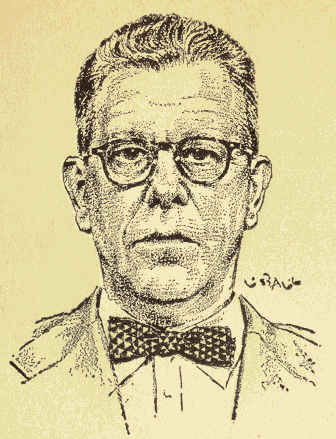How a self-educated Maine farm boy, filled with insatiable curiosity, became one of today's most respected experts in the complex field of electronics Percy Spencer and His Itch to KnowBy Don Murray PERCY SPENCER is the nosiest man I have ever known. Now 63, he still has an intense, small boy's compulsion to explore every wonder in the world around him. The results of his relentless curiosity have touched the lives of each of us. Recently I walked into his office at the Raytheon Manufacturing Co. in Waltham, Mass. - an office befitting the senior vice-president of one of the nation's largest electronic' manufacturers. "Hi, Don," the stocky, shirt-sleeved Down-Easter shouted from behind his desk. "Where'd you get the shoes?" The moccasin-type shoes weren't that different, but I knew Percy. Were the shoes comfortable, he asked. Would they wear? Why were they stitched like that? In a minute I had one shoe off, so that he could examine it. He wanted to know just how it was made. The story is typical of Percy Spencer's direct, homey approach, which he brings even to the miracle world of modern electronics. One day a dozen years ago he was visiting a lab where magnetrons, the power tubes of radar sets, were being tested. Suddenly, he felt a peanut bar start to cook in his pocket. Other scientists had noticed this phenomenon, but Spencer itched to know more about it. He sent a boy out for a package of popcorn. When he held it near a magnetron, popcorn exploded all over the lab. Next morning he brought in a kettle, cut a hole in the side and put an uncooked egg (in its shell) into the pot. Then he moved a magnetron against the hole and turned on the juice. A skeptical engineer peeked over the top of the pot just in time to catch a faceful of cooked egg. The reason? The yolk cooked faster than the outside, causing the egg to burst. Spencer had discovered that you could cook with high-frequency radio waves. He got a patent on the "radar range," one of the 225 he holds. The new device will cook a sirloin steak in one minute, a plump Thanksgiving turkey in little more than half an hour. Used for some time in restaurants, Pullman diners and ocean liners, radar ranges are now being produced for the home. This constant curiosity helped Percy Spencer turn an underprivileged childhood into an especially privileged one. Born in Howland, Maine, a remote rural community, he was twice orphaned when a child. His father died when he was 18 months old, and soon his mother left home, turning Percy over to an aunt and uncle. The uncle was like a father to him, but when Percy was only seven, this second father died. Percy didn't waste time feeling sorry for himself. He was too busy learning a country boy's chores - how to chop wood, hoe, saddle a horse, help with the preserving, skin a deer, saw a straight line and improvise solutions to the problems of survival, a skill famous as "Yankee ingenuity." When he was 12 he trudged off to the spool mill in the cold, gray Maine dawn and worked till after sundown. Four years later his curiosity led him into something new. The local paper mill was to be electrified. Although he had no formal knowledge of electricity (in 1910 few people knew much about it), Percy signed on as one of three men to install the system. Learning entirely by trial and error, he emerged a competent electrician. When, in 1912, the Titanic sank, the heroism of the wireless operators sparked the boy's imagination. He joined the Navy to learn wireless telegraphy. He did not mention his limited education when. The Navy sent him to its radio school. "I just got hold of a lot of textbooks and taught myself while I was standing watch at night," he explains. He has kept up this practice of self-education all his life-"solving my own situation," he calls it. There is no count of the hundreds of nights he has spent painfully working out problems in trigonometry, calculus, chemistry, physics, metallurgy and other areas of learning. Discharged from the Navy, he went to work for the Wireless Specialty Apparatus Co., of Boston. Spencer's insatiable curiosity is still remembered by his co-workers. In those days the whole shop would often keep going until midnight to finish an order. After the others had left, Percy would stay behind to test and examine the day's production. "Many's the time the gang would come back in the morning and find Percy still there," one of his friends recalls. "He had stayed up all night just to find out how things worked." He learned so well that he became a wireless-equipment production boss in World War 1, and was sent out on trouble-shooting missions by the Navy when he was barely old enough to vote. Then, during the late '20's and '30's, he worked with the growing Raytheon company. His experiments brought him into contact with many of the best physicists at Massachusetts Institute of Technology. One of them told me, "Spencer became one of the best tube designers in the world; he could make a working tube out of a sardine can. In 1929 Spencer was experimenting on photoelectric vacuum tubes when one developed a small leak. Many another scientist had arrived at same spot - and discarded the tube. Spencer didn't. Curious to know the consequences of the leak, he soon discovered that the tube's photoelectric quality had increased ten times. This was a major step in the development of the modern TV camera tube. When the Nazis marched into Poland in 1939, Percy Spencer became a man possessed. For the next seven years he worked every day, including Sundays and holidays. His power-tube division at Raytheon expanded from 15 employees to more than 5000 when the war ended. In addition to training huge groups of men and women, he rode herd on the construction of new buildings, argued for priorities on materials, fought for the latest equipment. Largely because of his legendary skill and ingenuity, Spencer won for Raytheon the contract to produce working models of combat radar equipment for M.I.T.'s Radiation Laboratory, which had mobilized scientists from all over the nation to work on the project. Next to the Manhattan Project, it had the highest World War 11 military priority. While the Battle of Britain was raging, the United States had received a model of a microwave (high frequency) magnetron from the British. Potentially, this was a weapon of incredible effectiveness, for the magnetron is the power tube, which is the heart of a radar set. The problem was how to mass-produce it. The vital tube had to be machined out of solid copper with tolerances of less than ten thousands of an inch. It took a master machinist a week to finish just one - and thousands were needed to help the RAF against the Luftwaffe. Spencer sweated night and day, driving himself and his workers, to speed up production. When his first "maggies" were flown to England, the RAF kill rate shot up. When we entered the war, 15 of Spencer's radar sets, - sensitive enough to spot German U-boat periscopes, were installed in U.S. bombers. They proved amazingly effective. By this time Spencer had heckled and badgered production up to 100 a day. He was still unsatisfied. On each trip through his plant he tried to figure ways to speed things up. At last, he sweated out a solution. Instead of carving the magnetron out of solid metal, Spencer, using a machine any semi-skilled worker could operate, stamped thin cross-sections of the tube out of copper and silver-solder. These were then piled alternately, one atop the other, and cooked into, a single piece on an ingenious conveyer-belt oven he designed. As a result of the new method, production of magnetrons jumped to an astounding 2600 a day. Next, Spencer invented a process which greatly increased the magnetron's efficiency, and designed several major refinements which made radar sets far more effective in combat. For his work he won the highest honor, the Navy can give civilians: the Distinguished Public Service Award. Talking about this feat, an M.I.T. scientist explained to me how Spencer operates: "The educated scientist knows many things won't work. Percy doesn't know what can't be done. Like Edison, he will cut and fit and try and throwaway and try again." Since the war Spencer has kept up his incessant rounds of the plant, poking his nose into everybody's business, cutting and fitting and throwing away. He has continued to improve his magnetrons, has in- vented microwave diathermy equipment with the cooperation of the Mayo Clinic. He has kept his power-tube division of Raytheon in the black throughout postwar economic gyrations. Every morning he gets to the plant before the night shift knocks off at 7 a.m. He listens intently to any night-shift workers who come to his office. "I let my people know I care," he explains. "When you work nights you think nobody cares what you do. I know; I used to be there." Spencer takes an almost aggressive interest in the people who work for him. On one of his plant inspection trips he noticed that a new employee wore a hat all the time, in doors and out. When Spencer found out the man was bald, he said, "Come with me." At the office of Raytheon president Charles Francis Adams, he flung open the door on the startled Adams, who is as bald as his great-great-grandfather, the second President of the United States, and his great-grandfather, the sixth U. S. President. "See," Spencer bellowed, "he isn't ashamed of not having hair!" Dr. Vannevar Bush, who has known Percy since he was a young man, after chuckling over several Spencer stories, warned me not to underestimate the homespun Down- Easter. "He has the respect of every physicist in the country, not only for his ingenuity but for what he has learned about physics by absorbing it through his skin. He is not merely a good experimenter and a good designer; he has become, in his own right, one of the recognized individuals in a very difficult field." Spencer's genius has received formal recognition as well. He is now a Fellow of the American Academy of Arts and Sciences, a member of the Institute of Radio Engineers and holder of an honorary Doctor of Science degree from the University of Massachusetts. Such honors have a special meaning in today's complex scientific world. For Percy Spencer, the orphan who never went beyond grammar school, has amply demonstrated that nothing is beyond the grasp of a man who wants to know what is going on, and who feels a sense of responsibility for doing something about it.
Related story - See the story of "Al" Spencer, Percy's brother, and his "Million Dollar Invention" This page last updated on July 16, 2014
|
||



